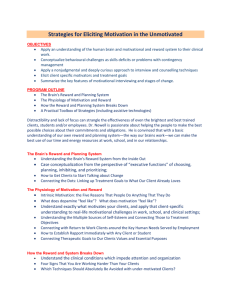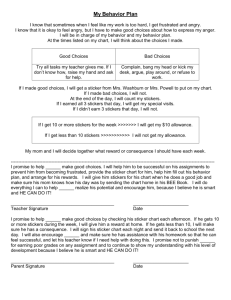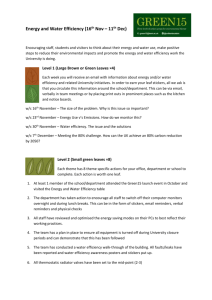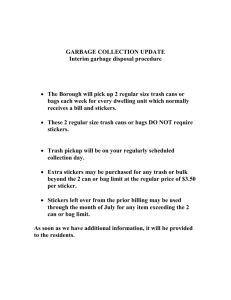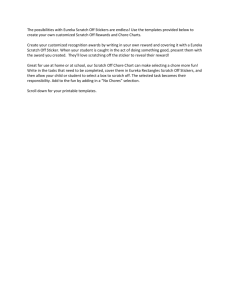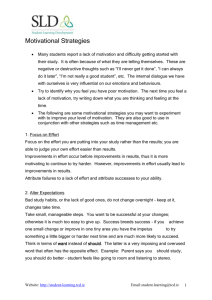Behavior/Motivational Strategies that Work
advertisement
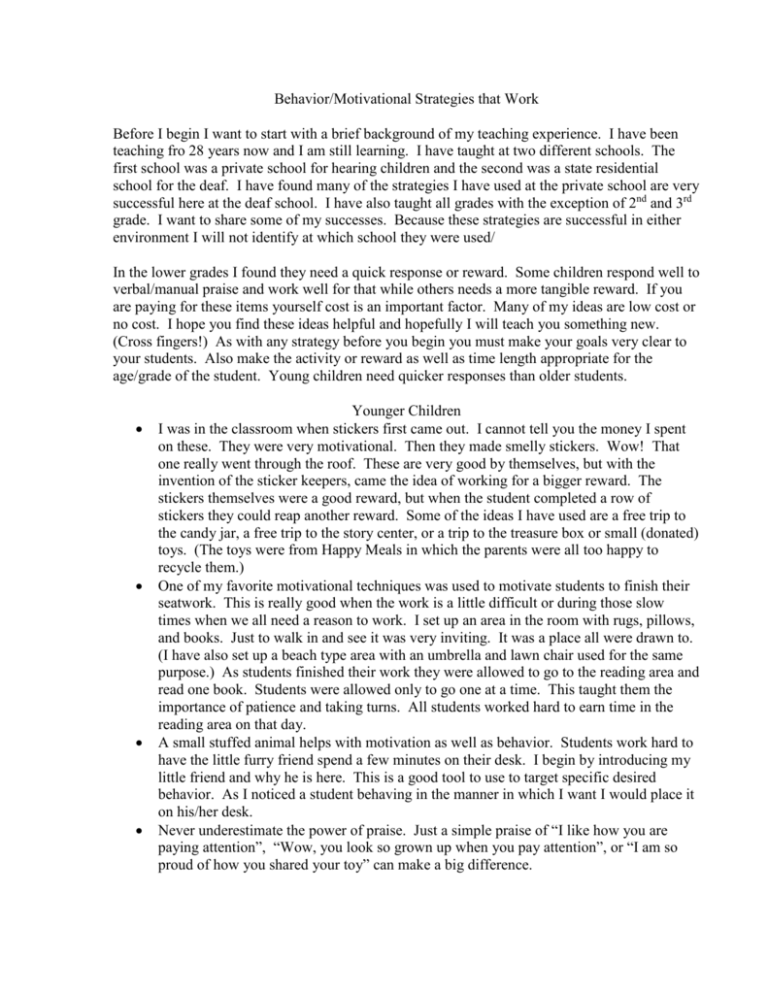
Behavior/Motivational Strategies that Work Before I begin I want to start with a brief background of my teaching experience. I have been teaching fro 28 years now and I am still learning. I have taught at two different schools. The first school was a private school for hearing children and the second was a state residential school for the deaf. I have found many of the strategies I have used at the private school are very successful here at the deaf school. I have also taught all grades with the exception of 2nd and 3rd grade. I want to share some of my successes. Because these strategies are successful in either environment I will not identify at which school they were used/ In the lower grades I found they need a quick response or reward. Some children respond well to verbal/manual praise and work well for that while others needs a more tangible reward. If you are paying for these items yourself cost is an important factor. Many of my ideas are low cost or no cost. I hope you find these ideas helpful and hopefully I will teach you something new. (Cross fingers!) As with any strategy before you begin you must make your goals very clear to your students. Also make the activity or reward as well as time length appropriate for the age/grade of the student. Young children need quicker responses than older students. Younger Children I was in the classroom when stickers first came out. I cannot tell you the money I spent on these. They were very motivational. Then they made smelly stickers. Wow! That one really went through the roof. These are very good by themselves, but with the invention of the sticker keepers, came the idea of working for a bigger reward. The stickers themselves were a good reward, but when the student completed a row of stickers they could reap another reward. Some of the ideas I have used are a free trip to the candy jar, a free trip to the story center, or a trip to the treasure box or small (donated) toys. (The toys were from Happy Meals in which the parents were all too happy to recycle them.) One of my favorite motivational techniques was used to motivate students to finish their seatwork. This is really good when the work is a little difficult or during those slow times when we all need a reason to work. I set up an area in the room with rugs, pillows, and books. Just to walk in and see it was very inviting. It was a place all were drawn to. (I have also set up a beach type area with an umbrella and lawn chair used for the same purpose.) As students finished their work they were allowed to go to the reading area and read one book. Students were allowed only to go one at a time. This taught them the importance of patience and taking turns. All students worked hard to earn time in the reading area on that day. A small stuffed animal helps with motivation as well as behavior. Students work hard to have the little furry friend spend a few minutes on their desk. I begin by introducing my little friend and why he is here. This is a good tool to use to target specific desired behavior. As I noticed a student behaving in the manner in which I want I would place it on his/her desk. Never underestimate the power of praise. Just a simple praise of “I like how you are paying attention”, “Wow, you look so grown up when you pay attention”, or “I am so proud of how you shared your toy” can make a big difference. Crowns are great for young children and special reading glasses for the best worker. I have used crowns for the best worker of the day and reading glasses for the best reader. I like to use sunglasses in a heart shape or star shaped frame. You can embellish them with Rhine stones or paint, or whatever your creative juices come up with. For students who are not as easily motivated I have had to call the parents in and work out a behavior plan with them. One successful idea was with a particularly difficult student. This was successful because the student was a day student and returned home every day. The parents were also very supportive and willing to work with me. I used a sticker keeper as a simple and easy way of letting the parents know about their child’s behavior for that day. On the sticker keeper I listed the areas that needed improvement and the days of the week. If the child was very good he got a +, if he needed improvement I used a – and if it was somewhere in between I used a check. Below is an example of a possible chart. Any form of mark can be used. Monday Tuesday Wednesday Thursday Friday Pays Attention: works + independently Cooperates Finishes work A stuffed animal that can be sent home with the child is also very motivating. I have taken an old stuff animal that my own child at home did not want and brought school to use. The animal would go home or could go to the dorm for one night with the winner.


